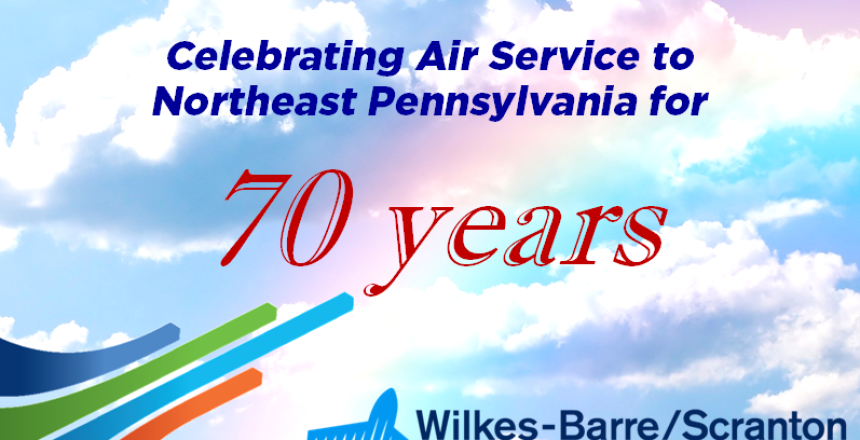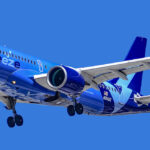Avoca, PA – The Wilkes-Barre/Scranton International Airport in Avoca, Pennsylvania, opened its doors on June 1, 1947. Now in 2017, after 70 years of service, we are happy to reflect on a rich history of aviation in the Northeast and the contributions both historically and economically our facility continues to make to our community and region.
The 1930s produced an air age in the local airport sense. The largest Northeastern Pennsylvania cities began to realize the need of a mile-wide airport the future would soon impose. This was the dawn of the age of mass air transportation. Despite the crippling depression and hard times affecting our single coal mining industry, a windfall multi-million dollar opportunity to plan and build a regional airport was presented at this time to Luzerne and Lackawanna Counties through their Public Works Administration.
To the credit of the two Counties’ boards of County Commissioners, it must be said that earliest site selection (Avoca), and their 1939 surveying of that location evidenced their sincere intent to cooperate, and their conviction as to the necessity of a modern “massive” airport to serve the entire multi-county region for economic survival.
In 1941, John B. McDade, Congressman Joseph M. McDade’s (his name bears the current Terminal Building) father and president of the Heidelberg Coal Co., donated 122 acres on which part of the Airport now sits. Most of the Airport land was previously owned by various coal companies. Many were less philanthropic than John McDade.
Many U.S. airfields built in the World War II era were motivated as much by military defense as they were by commercial aviation. The government funded construction of many airfields to develop a network that could be used by military planes if needed.
The diehard proponents of a large bi-county airport continued in their imaginative and progressive efforts in the early forties until late in 1944, when they succeeded in receiving a last minute commitment from the Administrator of Civil Aeronautics of the United States Department of Commerce, with the approval of a Board composed of the Secretary’s of Navy, War, and Commerce in designating as necessary for national defense a project for the development of the Airport at Avoca.
Early in 1945, more history was made in the form of the once arch-rival counties entering into legal agreement to co-sponsor and operate the Airport. During those delicate negotiations on site selection and the bi-county operation plan, it was agreed that Scranton, the larger city and alphabetical first and closest in mileage should have second billing in name, since Luzerne County had the largest population, thus: the Wilkes-Barre/Scranton Airport was indelibly named.
The years 1945 through 1947 witnessed the amazing transformation of an utterly devastated and depression-ravaged coal-stripping and garbage-strewn landscape, up the hills above Avoca east of the Laurel Line tracks, into an extensive and beautiful man-made grassy plateau.
On June 1, 1947, the Wilkes-Barre/Scranton Airport was dedicated with fanfare. The debut commercial passenger service for the region was witnessed by thousands in attendance.
Colonial Airlines and American Airlines were the first two airlines at AVP. Within two years, Transcontinental and Western (April 1948), and All American Airlines (June 1949) were added. Colonial provided Montreal/Syracuse-Philadelphia/Washington and intermediate stop service; American provided Chicago/Buffalo-New York Service; T.W.A. provided Kansas City/Pittsburgh-Albany/Boston service; and All American provided a general interstate service and later a looping network to Newark, Atlantic City, Washington, and around again through Pennsylvania.
The first airline equipment here, used by all four carriers, was the DC-3, a 21-passenger airplane weighing about 25,000 pounds, which cruised anywhere between 155-165 mph.
Today, the Wilkes-Barre/Scranton International Airport is currently home to four airlines: American Airlines, providing service to Charlotte and Philadelphia; Delta Air Lines, providing service to Atlanta and Detroit; United Air Lines, providing service to Chicago and Newark; and Allegiant, providing service to Orlando-Sanford and Tampa/St. Petersburg.
A new era began a little over a decade ago when the Joseph M. McDade Terminal Building opened to the public on May 25, 2006. The $41.5 million steel, stone and glass structure was the last piece of a makeover of the Airport. New roads, a four-level parking garage, a surface parking lot, ramps, aprons and taxiways were also completed, bringing the total cost to approximately $80 million.




